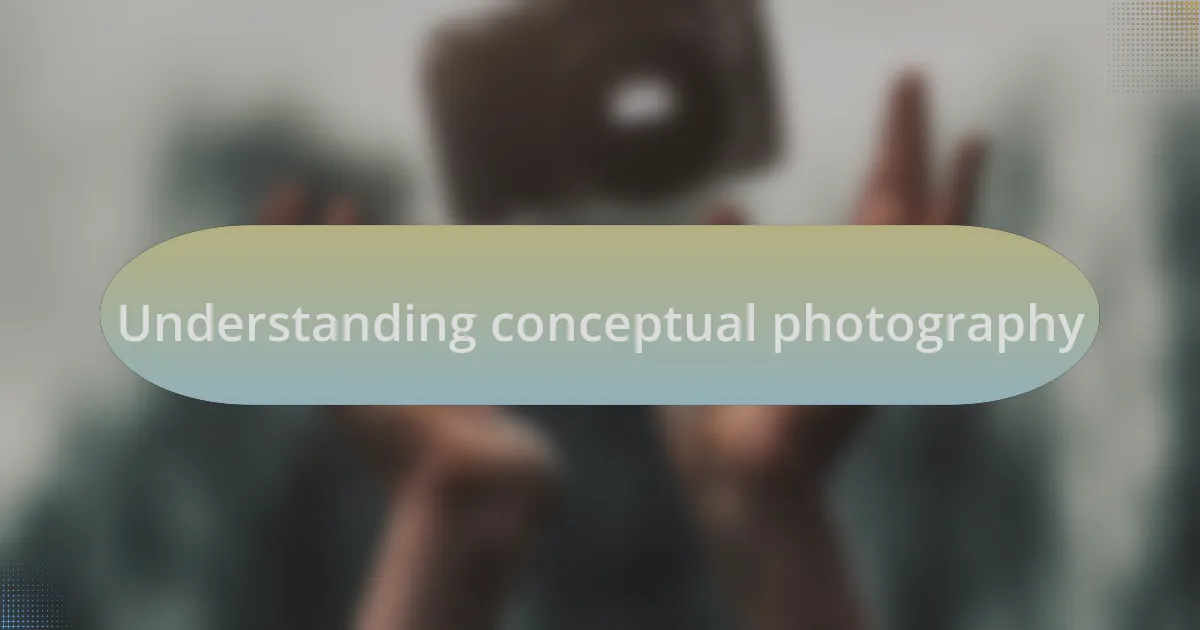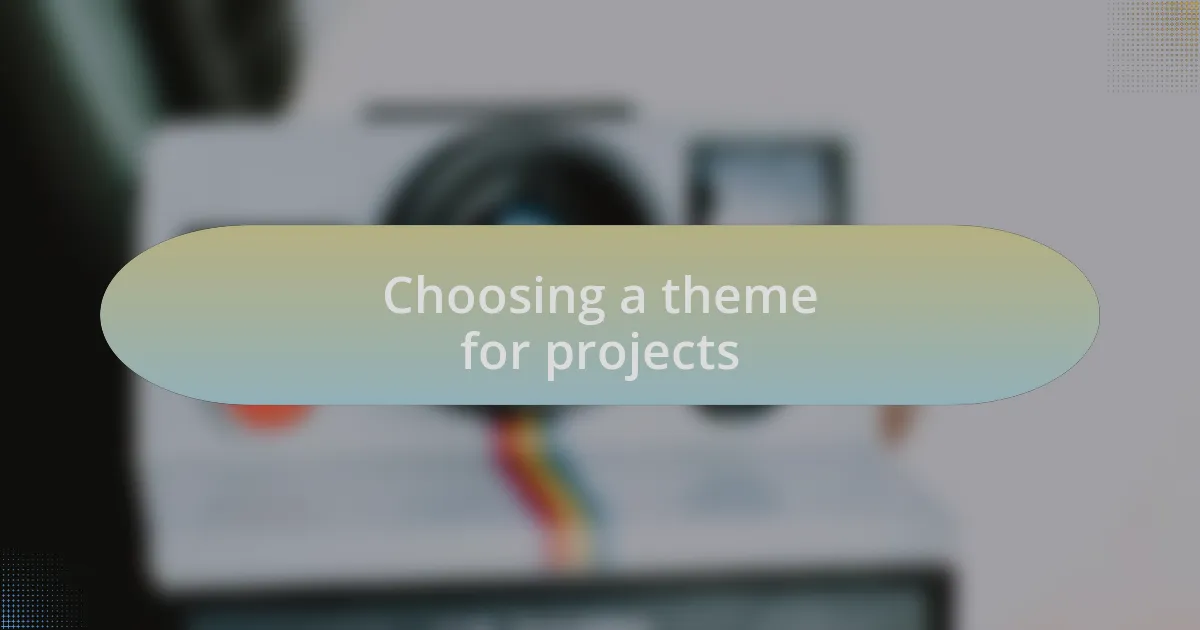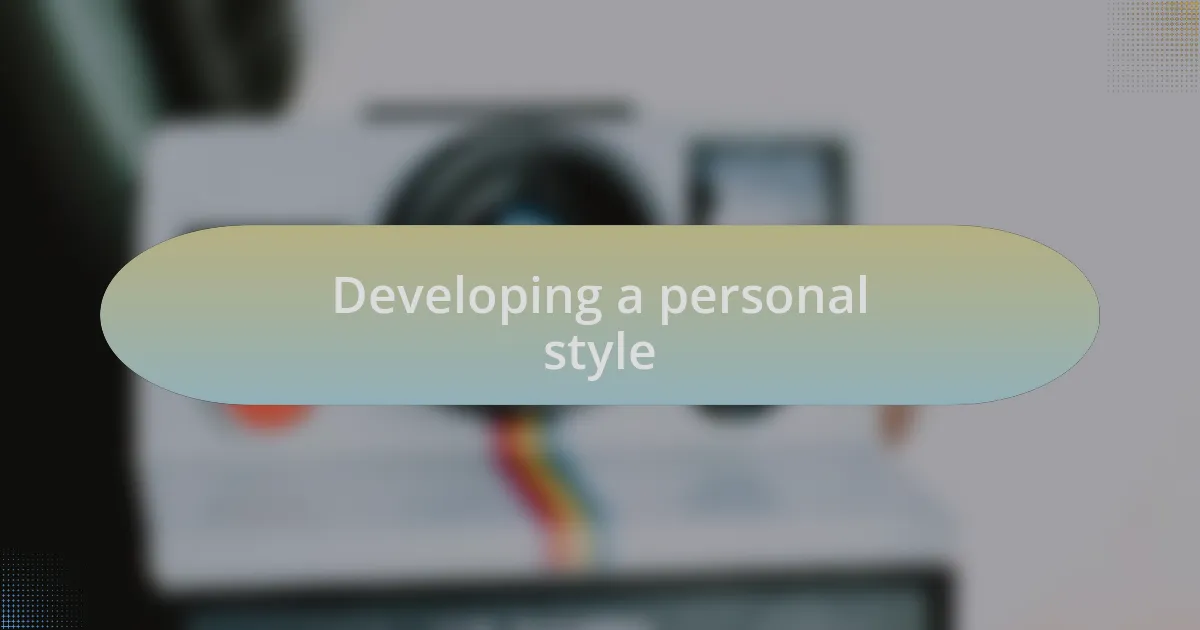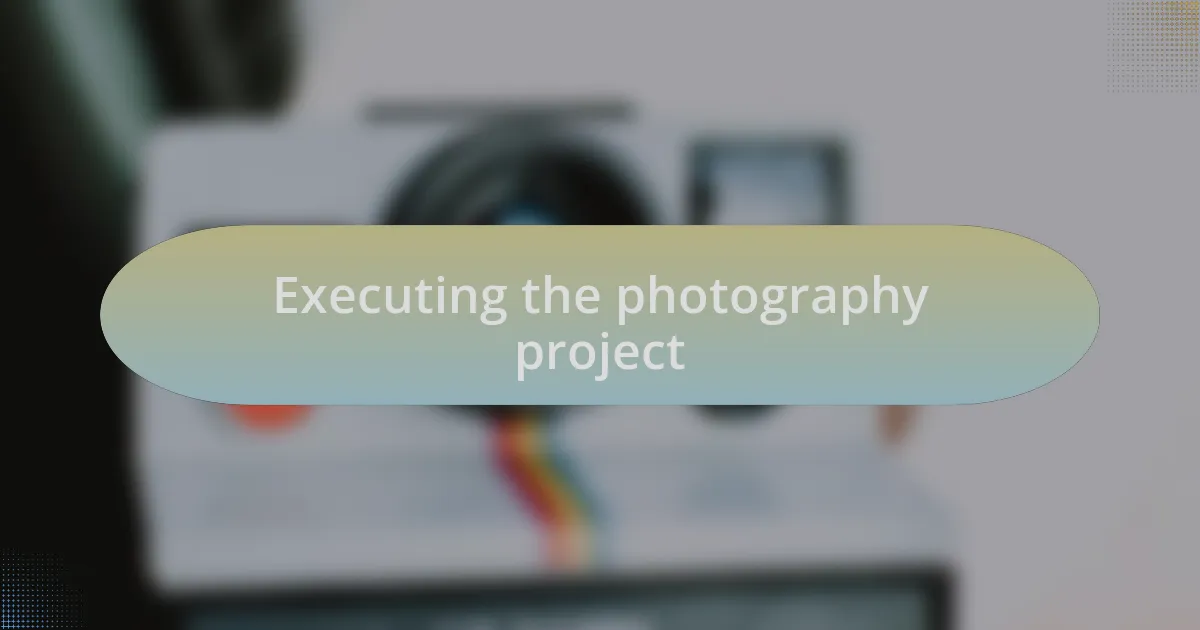Key takeaways:
- Conceptual photography focuses on conveying ideas and emotions through visual storytelling, transforming ordinary elements into profound narratives.
- Planning is crucial for a cohesive photography project, guiding the creative process and allowing for intentional experimentation.
- Selecting a central theme shapes the creative lens, providing a framework for storytelling and emotional resonance.
- Reflecting on and revising work fosters self-discovery and improvement, often revealing hidden beauty and adding depth to the narrative.

Understanding conceptual photography
Conceptual photography goes beyond the mere act of taking pictures; it’s about conveying ideas and emotions through visual storytelling. I remember my first conceptual shoot where I struggled to translate my thoughts into images. The moment I understood that every element in the frame could serve a purpose—that’s when my art truly began to resonate.
When I approach a conceptual project, I often ask myself what message I want to communicate. Have you ever looked at a photograph and felt an immediate connection? That rush is what drives me to create images that provoke thought and stir emotions. I find that each image should provoke questions, inviting viewers to engage with the narrative more deeply.
Emotions play a crucial role in my conceptual work. In one of my projects, I explored themes of isolation and connection through empty chairs in urban settings. The stillness of those chairs spoke volumes, and I felt a profound sense of vulnerability as I captured them. Have you ever noticed how a simple object can convey so much? That’s the power of conceptual photography—it transforms the ordinary into the extraordinary, encouraging us all to look beyond the surface.

Importance of planning projects
Planning a photography project is essential to ensure that the vision translates seamlessly into visual form. I recall a project where I aimed to capture the essence of fleeting moments in life. Initially, I went without a detailed plan, but the results felt disjointed and lacked coherence. That experience taught me that a solid plan not only guides the creative process but also reinforces the narrative I want to convey.
Setting clear goals allows me to shape each element in a shoot intentionally. For instance, when I worked on a project centered around dreams, I structured my approach around specific themes—light and shadow, reality versus imagination. Did I ever imagine that a detailed shot list would help keep a sense of direction? Absolutely! It was like having a roadmap, directing me toward capturing the heart of my concept without getting lost in the details.
Moreover, planning encourages me to experiment and evolve. By mapping out different scenes and concepts beforehand, I give myself the freedom to take creative risks during the shoot. I once had the opportunity to photograph an abandoned building, and my original plan changed drastically once I arrived on location. Still, having that framework in place allowed me to adapt without losing sight of my overarching vision. Isn’t it fascinating how flexibility within a structured plan can lead to unexpected discoveries?

Choosing a theme for projects
Choosing a theme for my photography projects is a foundational step that genuinely shapes the entire creative process. I often start by reflecting on my emotions and experiences. For one project, I chose to explore loneliness, a theme that felt particularly relevant during a time of isolation in my life. Capturing images that conveyed this heavy sentiment required more than just technique; it involved vulnerability and a deep understanding of the mood I wanted to evoke.
It’s interesting how a central theme can provide a unique lens through which to view the world. I remember picking “transience” as a theme for a series on nature’s fleeting beauty. As I wandered through blooming flowers, I had an epiphany: those delicate petals, which only lasted a short while, mirrored my own experiences of impermanence. This realization not only guided my composition but also fueled my passion, resulting in a project that resonated deeply with viewers.
Ultimately, the theme I select becomes a conversation starter—not just between me and my subjects, but with the audience too. I’ve often asked myself, “What emotions do I want my viewers to feel?” This question drives my exploration. When I focused on “hope” in a documentary about urban life, the challenge was to find moments that resonated with optimism amidst the chaos. The theme acted as a lighthouse, guiding my camera to capture not just what was there, but what I hoped others might see and feel.

Researching ideas and inspiration
Researching ideas and inspiration is a thrilling part of my photography journey. I often immerse myself in literature, films, and even music to spark my creativity. For instance, while reading a novel that delved into themes of memory, I found myself contemplating how I could visually interpret memories in a series of portraits. Isn’t it fascinating how different art forms can influence our perspective within our medium?
Online forums and social media platforms are another excellent source for discovering ideas. I remember scrolling through a photography group when I stumbled upon someone’s project focused on urban decay. It inspired me to explore my own neighborhood, and I began capturing the stories hidden in worn-out buildings and neglected spaces. How can something so broken reveal so much beauty? That question ignited my exploration and showcased the power of community in shaping our artistic vision.
Additionally, I keep an inspiration journal where I jot down ideas, quotes, and photographs that resonate with me. Recently, I revisited a set of images taken during a rainstorm, where droplets danced on glass surfaces. Reflecting on those moments led me to consider a project that juxtaposed nature and urban elements. I think about how holding onto snippets of inspiration can be pivotal; they often reveal much about my creative intentions. Have you ever found inspiration in unexpected places? It’s a reminder that the world is full of potential—if we’re just willing to look.

Developing a personal style
Developing a personal style in photography is a journey that reflects who we are as individuals. For me, it often starts with self-reflection; I ask myself what emotions I want to convey and what stories I wish to tell. I vividly recall a project where I focused on solitude; by capturing empty spaces and lone figures, I could express a sense of longing that resonated deeply with my own experiences. Have you ever thought about how your emotions can shape your artistic vision?
As I fine-tune my style, I find it essential to experiment with different techniques and approaches. I remember one day during a workshop where I tried long exposure photography for the first time. I was drawn to the way it transformed movement and created a dreamy sense of time. Sometimes, I fail spectacularly, but those failures offer insights that help refine my approach. Isn’t it liberating to think that each misstep brings us closer to our unique artistic voice?
Ultimately, it’s about finding what feels authentic. I often revisit older photographs that no longer satisfy me—what was once exciting can feel stale over time. I try to understand how my perspective has shifted and how it can inform my current projects. Isn’t that part of the beauty of evolving as an artist? Embracing change is integral to nurturing a style that truly resonates with us.

Executing the photography project
When it comes to executing a photography project, preparation is key. I often spend time brainstorming concepts, jotting down ideas that spark my interest. For instance, during a project focused on urban decay, I wandered through abandoned buildings, allowing the environment to influence my vision. Have you ever walked through a space and felt its history echoing back at you?
I believe that flexibility during the shoot can lead to unexpected breakthroughs. A few months ago, while working on a themed project about light and shadow, I encountered a moment when the sunlight shifted dramatically. Instead of sticking to my initial plan, I adjusted my angles, capturing shadows that added depth and drama I hadn’t anticipated. Isn’t it thrilling how spontaneity can sometimes result in the most compelling images?
Post-shoot, I immerse myself in the editing process, which is where the project truly takes shape. I find that it’s essential to reflect on what each image conveys about the theme. Recently, while editing a series about community, I realized that adjusting the color tones brought out different emotions in the images. How do you decide which edits align best with your artistic vision? I often remind myself that each choice shapes the narrative my project tells, enhancing its emotional impact for the viewer.

Reflecting on and revising work
Reflecting on my work is a vital part of my process, often leading to unexpected revelations. After completing a project, I like to step back and assess what I’ve created with a critical eye. For example, while reviewing images from a series on solitude, I found certain compositions that I first overlooked were surprisingly powerful. Have you ever been amazed by how a second look can reveal hidden beauty or meaning in your work?
Revising my images has become a practice of self-discovery. Sometimes, I’ll spend hours tweaking a single photo, adjusting the exposure or cropping for clarity. I recall one instance where I spent an evening revising a shot that initially felt flat. By the end, that image transformed into a striking representation of stillness, capturing a moment I hadn’t fully appreciated before. Isn’t it incredible how a small shift can redefine the narrative entirely?
Another essential aspect is seeking feedback from peers. Often, I’ll share my revisions with fellow photographers, who provide fresh perspectives that I might not have considered. I remember a recent conversation with a colleague who pointed out a subtle detail I had missed, which added an entirely new layer to my work. How do you incorporate external feedback into your creative process? For me, it serves as a compass, guiding me towards improvements I sometimes overlook in my own reflections.